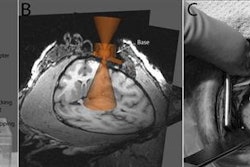The group performed 1.5-tesla MRI scans (Magnetom Avanto, Siemens Healthineers) with the addition of a whole-body resonator receiver coil on 195 patients (mean age, 29.1 ± 19.9 years) suspected of having liver iron overload.
A liver-to-muscle signal-intensity ratio was calculated manually by placing three regions of interest (ROIs) in vessel-free parts of the liver and two ROIs in paraspinal muscles, followed by a linear regression logarithm to reference liver iron content. The result produced a liver iron content value based on gradient-echo data.
The method resulted in 48 true negatives and two false negatives, along with 143 true positives and two false positives. Thus, it achieved a sensitivity of 98.6%, specificity of 96%, positive predictive value of 98.6%, and negative predictive value of 96%. Accuracy was 98%.
"The most important benefit of our method is that liver iron determination based on gradient-echo MRI is much faster than the established spin-echo method," Arthur Wunderlich, PhD, from Ulm University, told AuntMinnie.com. "The information provided is the liver iron content, and with our method results are available instantly after the MRI scan, sparing extensive analysis and/or data transfer."



















